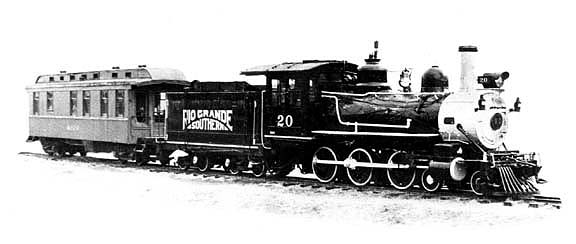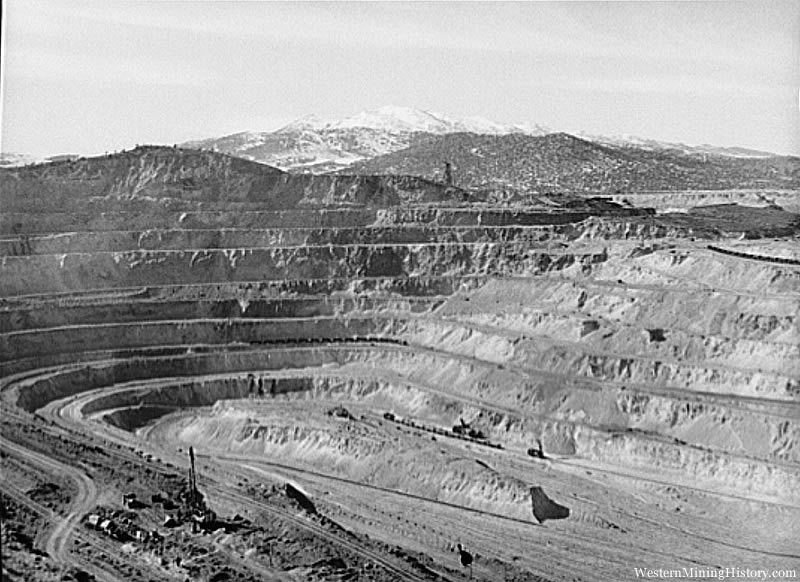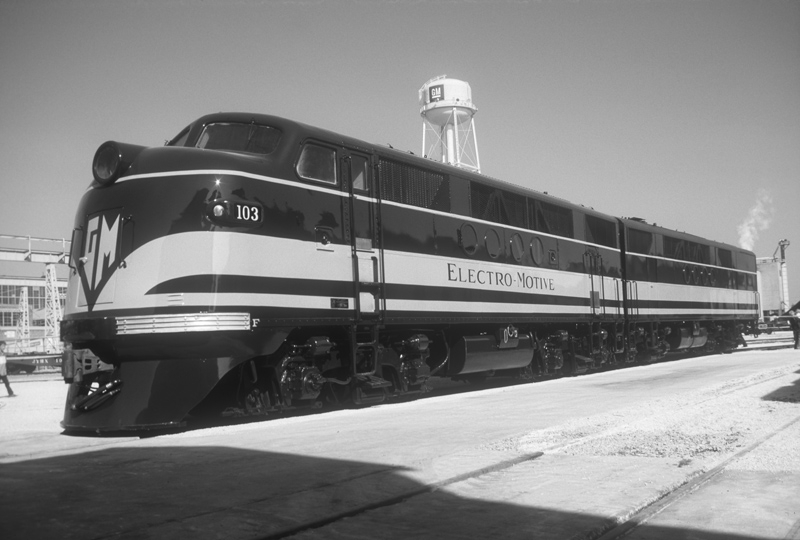 The Santa Fe Southwestern was chartered in 1901 as a narrow gauge line built primarily to serve several local mines. The original route stretched north roughly 57 miles from Dover, California on the Santa Fe main, to the mining district around Copper Mountain. The line prospered from the start and by the beginning of the World War 1, the railroad had gained Class I status. As production at each of the mines increased, several of the smaller mines merged and expanded, consolidating the operations of 11 separate companies under one umbrella. By the end of World War 1, the line was rebuilt to standard gauge and by mid-1928, there were 4 large operations going in the newly formed Copper Mountain Mining District. The Depression was the first major test of the railroad's prosperity as it saw the closing of all but one of the mines, the Copper Mountain Mine, and almost saw the demise of the railroad itself. Miraculously, due to the unusually high grade of the ore, the railroad survived. With America’s entry into World War II, and the sudden demand for copper, the company's future was secured.
The Santa Fe Southwestern was chartered in 1901 as a narrow gauge line built primarily to serve several local mines. The original route stretched north roughly 57 miles from Dover, California on the Santa Fe main, to the mining district around Copper Mountain. The line prospered from the start and by the beginning of the World War 1, the railroad had gained Class I status. As production at each of the mines increased, several of the smaller mines merged and expanded, consolidating the operations of 11 separate companies under one umbrella. By the end of World War 1, the line was rebuilt to standard gauge and by mid-1928, there were 4 large operations going in the newly formed Copper Mountain Mining District. The Depression was the first major test of the railroad's prosperity as it saw the closing of all but one of the mines, the Copper Mountain Mine, and almost saw the demise of the railroad itself. Miraculously, due to the unusually high grade of the ore, the railroad survived. With America’s entry into World War II, and the sudden demand for copper, the company's future was secured. As the demand for high grade copper grew during and after the war, so did the demands placed on the railroad’s aging equipment. Management decided that it needed bigger and better locomotives as well as better track. Using revenue from the increasing ore shipments, the line was rebuilt and the track south of Elwood was double tracked. Soon after the war, the line was extended further north to a connection with the Union Pacific at Jean, Nevada, prompted by the closure of the main smelter that received much of the ore traffic. The original survey took the northern extension through some rough terrain that included a tunnel, but the railroad was not satisfied and sought out an easier route. A new survey was commissioned and a route was found that eliminated the tunnel and kept the grade relatively flat. The new route also added a few miles, but this was a small price to pay for the service improvement that was about to take place. By 1960, the new line was officially opened to traffic and the original route between Elwood and Jean was taken out of service. The new alignment, which maintained the UP connection at Jean, was a faster, less strenuous route that allowed quicker shipment of ore to the north and eliminated many of the speed restrictions that hampered traffic flow. Another benefit of the realignment was the increased transfer traffic from the UP to the ATSF with cars bound for customers on the SFSW. The railroad was now in a position to start making orders for new cars to handle the increasing ore shipments and at the same time, the railroad bought its first diesel locomotives.
As the demand for high grade copper grew during and after the war, so did the demands placed on the railroad’s aging equipment. Management decided that it needed bigger and better locomotives as well as better track. Using revenue from the increasing ore shipments, the line was rebuilt and the track south of Elwood was double tracked. Soon after the war, the line was extended further north to a connection with the Union Pacific at Jean, Nevada, prompted by the closure of the main smelter that received much of the ore traffic. The original survey took the northern extension through some rough terrain that included a tunnel, but the railroad was not satisfied and sought out an easier route. A new survey was commissioned and a route was found that eliminated the tunnel and kept the grade relatively flat. The new route also added a few miles, but this was a small price to pay for the service improvement that was about to take place. By 1960, the new line was officially opened to traffic and the original route between Elwood and Jean was taken out of service. The new alignment, which maintained the UP connection at Jean, was a faster, less strenuous route that allowed quicker shipment of ore to the north and eliminated many of the speed restrictions that hampered traffic flow. Another benefit of the realignment was the increased transfer traffic from the UP to the ATSF with cars bound for customers on the SFSW. The railroad was now in a position to start making orders for new cars to handle the increasing ore shipments and at the same time, the railroad bought its first diesel locomotives. Initially, upon completion of the northern extension, several locomotives were leased from the Atchison, Topeka, & Santa Fe to supplement the dwindling steam roster. In 1965, the company purchased an F7A/B set from the leased Santa Fe equipment along with a pair of SD9's from SP. With these purchases, the railroad decided to retire its last steam engine, a 2-8-2 Mikado, and thereby totally dieselizing its operations. Instead of being scrapped or placed on display, though, the steam engine was rebuilt and retained to the power the executive train as well as other special occasions as the managers saw fit. As a steady cash flow developed, the railroad focused on more motive power and equipment, purchasing several used locomotives to help with the heavy traffic. By 1990, the SFSW purchased it's first new diesel locomotive, a GE B40-8. The locomotive was delivered in a striking new paint scheme of sand and maroon, which became the new look for the company. The SFSW now rostered six road locomotives and in early 1991, the railroad went back to GE with the purchase of two new C40-8’s. That same year the F7 was taken out of regular service and is stored in the roundhouse in serviceable condition.
Initially, upon completion of the northern extension, several locomotives were leased from the Atchison, Topeka, & Santa Fe to supplement the dwindling steam roster. In 1965, the company purchased an F7A/B set from the leased Santa Fe equipment along with a pair of SD9's from SP. With these purchases, the railroad decided to retire its last steam engine, a 2-8-2 Mikado, and thereby totally dieselizing its operations. Instead of being scrapped or placed on display, though, the steam engine was rebuilt and retained to the power the executive train as well as other special occasions as the managers saw fit. As a steady cash flow developed, the railroad focused on more motive power and equipment, purchasing several used locomotives to help with the heavy traffic. By 1990, the SFSW purchased it's first new diesel locomotive, a GE B40-8. The locomotive was delivered in a striking new paint scheme of sand and maroon, which became the new look for the company. The SFSW now rostered six road locomotives and in early 1991, the railroad went back to GE with the purchase of two new C40-8’s. That same year the F7 was taken out of regular service and is stored in the roundhouse in serviceable condition.